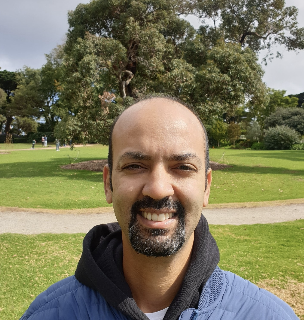Date
2pm – 4pm (AEST)
2pm – 4pm (AEST)
2pm – 4pm (AEST)
REGISTER
This is an online Zoom event. Find out more about registration for the 12th of Aug Showcase: https://www.ml4au.community/other-events/showcase-event-2
To visit the ML4AU community page, click here: https://www.ml4au.community
About the Showcase
The ARDC Machine Learning Showcase led by ML4AU Monash University is an opportunity to identify common opportunities, gaps and challenges in applying ML, that can be addressed and resolved collaboratively through ML CoP. This event is also an opportunity to display the projects that have successfully applied ML to their research or are on the road to doing so. ML4AU is supported by the Australian Research Data Commons (ARDC), Monash University, the University of Queensland, NCI, Pawsey and QCIF. The ARDC is enabled by NCRIS.
There are three sessions that will feature lightning talks across a wide spectrum ML application in different domains across Australian research community. NCI contributes to all three sessions.
Here are our third and fourth NCI presentations on the 12th of August. See details below:
Assoc. Prof. Ziv Hameiri
Title: Advanced analytics and machine learning approaches for photovoltaic applications
The Intergovernmental Panel on Climate Change (IPCC) set a clear goal of a third of the planet’s energy to come from renewable sources by 2030. Of these sources, photovoltaic (PV) energy has a key role in achieving the IPCC’s target as it already provides the cheapest electricity. Silicon solar cells currently are the most prominent PV technology, with a market share above 90%. Nevertheless, continuous improvement of solar cell efficiency and reliability is required to further accelerate the transition toward solar-based electricity generation.
In this presentation, we will present a few applications of machine learning that assist in improving solar cell efficiency and reducing their cost.
About the presenter
Ziv Hameiri is an Associate Professor at the School of Photovoltaic and Renewable Energy Engineering (SPREE), UNSW. He was awarded his PhD by UNSW in March 2011 for a thesis entitled Laser-Doped Selective Emitter and Local Back Surface Field Solar Cells with Rear Passivation. He was then a Research Fellow at the Solar Energy Research Institute of Singapore between 2011 and 2014. In 2014 he was awarded the UNSW Vice-Chancellor’s Research Fellowship and in 2015 he received the Australian Research Council (ARC) Discovery Early Career Researcher Award (DECRA) for projects that improved the quality of silicon wafers.
Currently, he is leading a group of 8-10 PhD students and several Research Fellows developing new characterisation methods for photovoltaic devices, including machine learning tools to study defects and other loss mechanisms in silicon wafers, cells, and modules. The group's research impact and contributions have been recognized through many awards and grants, such as five Best Student Awards in the last four years, two UNSW Staff Excellence Awards in Research Excellence Science, and an HDR Supervision Award. Ziv also completed Al Gore’s Climate Reality Leadership program
Assoc. Prof. Fabio A. Capitanio
Title: Towards understanding earthquakes physics: A machine learning approach
Understanding the controls on mega-earthquakes along subduction zones remains an open challenge and an exceptional hazard for the whole community. The occurrence of earthquakes depends on a set of state-variables and force-balance of plate tectonics, with complex interactions across scales, from the pull of the mass in the Earth’s deep interiors to the distribution of plate interface properties. Evidence of such complexity is the seismic catalogue, characterised by a short and sparse temporal record of very different events, from the rare occurrences of the largest earthquake along mega-thrusts (e.g., Sumatra, 2004, Tohoku, 2011) to smaller ruptures, with low energy and different characteristics. We discuss challenges and approaches and present the preliminary results of a combined machine learning – physics approach. We embed in the input layer of a fully coupled network the seismic catalogue of specific subduction zones and terms constrained by forward finite-difference solutions of the elastic stress state to the input layer. We present strategies and preliminary results of a classification procedure aimed at the prediction of earthquake magnitude Mw and discuss the approach to evince the relevant physics from this approach.
About the presenter
Fabio is an Associate Professor at the School of Earth, Atmosphere and Environment, Monash University. He is interested in many aspects of the Earth’s dynamics, from seismicity to tectonics-climate interactions, from mountain building to global plate motions, which he tackles using a range of modelling methodologies, from high performance computational mechanics to application of deep learning. He completed his doctoral studies at ETH Zürich, Switzerland, and has been awarded a Decra and a Future Fellowship, by the Australian Research Council, and the Jason Morgan Early Career Award, by the American Geophysical Union. At Monash, he leads a group of several PhD students and Post-doctoral researchers Fellows working on different applications of computational approaches to the Earth Sciences.
Here are the first two NCI users presented their ML applications on Gadi on the 24th of June. You can find the recording of the #1 showcase here on YouTube.
Dr Tu Le (RMIT)
Title: Weaving through the boundless material space with machine learning
The design and synthesis of materials with useful, novel properties is one of the most active areas of contemporary science, generating a veritable explosion of scientific activity in areas such as biomaterials, cell and tissue engineering, organic photovoltaics and light-emitting materials, and nanomaterials for a myriad of medical and nonmedical applications. This new era of materials design and discovery covers many disciplines from chemistry and biology to physics and engineering. To accelerate the pace of novel materials discovery, computational methods such as artificial intelligent machine learning techniques can be used to construct predictive materials property models and allow rapid scanning of large chemical datasets to systematically identify attractive candidates for specific applications. This presentation will showcase my tiny exploration in the vast material space in the search for functional materials for applications such as aerospace and antifouling materials.
About the Presenter
Dr. Tu Le is a Lecturer at the School of Engineering, RMIT University. For the last decade, her research has been focused on applying machine learning approaches to design and develop functional materials. The goal of these projects is to efficiently design fit-for-function materials by mapping the relationship between materials structures or processing conditions and their physicochemical properties. The application of these materials varies from drug delivery, anti-fouling coating, to hydraulic fluid for aircrafts. Her research impact and contributions have been recognized through many awards and grants, such as the Jacques-Emile Dubois award, CASS Foundation travel grant, and the joint Japanese Society for the Promotion of Science – Australian Academy of Science grant for attending the HOPE meeting with Nobel Laureates.
Dr Sherif A. Tawfik Abbas (Deakin University)
Title: Rapid material discovery with machine learning
A major challenge in materials science is to find the right material for a given task. The space of possible new materials is endless, and researchers around the world have been populating online materials databases with millions of materials along with their predicted properties. Therefore, if an experimentalist is looking for a material with a particular set of requirements, it is in principle possible to find a material that could nearly match those requirements by searching the databases. The databases have been quite useful: many of the materials in these databases have been predicted to be potential candidates for applications in many areas such as photonics, medicine, superconductivity, energy and programmable materials.
However, some material properties are still not available in those massive databases. Thermal properties are available only for a very limited number of materials because they are highly complex to calculate. And while two-dimensional (2D) materials are available, hybrid 2D materials are not there yet, and therefore it is not possible to predict the properties of the possible 20 million hybrid 2D materials. Machine learning is a powerful approach that can help predict complex materials properties, and has recently been attracting attention owing to the high accuracy of its predictions and the versatility of its applications. Here I will demonstrate how we use machine learning to accurately predict thermal properties for materials as well as the properties of hybrid 2D materials. I will also give an overview of my current research at the Institute for Frontier Materials for my work in the ion battery domain, and the ARC Centre of Excellence for Exciton Science for predicting properties related to photovoltaic materials.
About the Presenter
Dr Sherif A. Tawfik Abbas holds a PhD of Physics from the University of Sydney (2017) and is currently an Alfred Deakin Postdoctoral Research Fellow at the Institute for Frontier Materials at Deakin University, and an Associate Investigator at the ARC Centre of Excellence for Exciton Science. He works at the cross-roads between first principles computations, material science and machine learning to answer questions in photovoltaic materials, artificial synaptic junctions, and battery materials.




